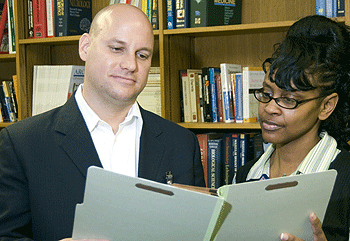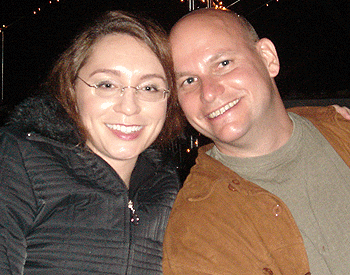When Keith S. Garcia was a boy, he wanted to build rockets. He probably wasn’t the only one in his neighborhood, either, growing up in Houston, the home of the Johnson Space Center and Mission Control for the Apollo moon flights of the late 1960s and early 1970s.
His dad was an engineer, and Keith liked science, but his dreams focused on applied science rather than medicine. Although his maternal grandfather had been a surgeon, Garcia never really thought about becoming a doctor himself.

“My first exposure to biology was really unpleasant,” he says.
But that changed in high school when a chemistry teacher got him interested in biochemistry. Later, as an undergraduate at Rice University, he planned to get a doctorate in biology and use that degree as a basic, biological scientist.
But then he learned about a combined M.D./Ph.D. program and started thinking about applying science to real-world problems.
“I thought medicine must be like the applied science of biology, that becoming a doctor was somehow similar to becoming a biology engineer,” Garcia says. “When I got into the program, however, I realized that at times being a physician/scientist was a little like being a bus driver/plumber. They can just be two completely different things.”
While learning that medicine wasn’t simply “applied biology,” he also discovered he enjoyed interacting with patients. In fact, he really liked psychiatry. Garcia did basic neuroscience research while earning a doctorate. He found that in psychiatry, he could apply some of that basic research and also listen to people tell him their stories.
The same sort of thing attracted his brother, Donald, to the field. Back when Keith was interviewing for medical school, he told his mother that an interest in the brain had him thinking about psychiatry as a specialty. He didn’t realize it, but his brother, a third-year medical student at the time, had decided on a similar career path. Later, he learned his father had originally wanted to be a psychiatrist, but when he went to Tulane University for undergraduate training, there were no pre-med scholarships available, so he took an engineering scholarship instead.
“Maybe there’s a psychiatry gene in my family,” Garcia says.
Garcia spends most of his time in the clinic, seeing patients eight to 10 months each year. He also spends a lot of time teaching medical students and psychiatry residents. He came to the University as a psychiatry resident and eventually became chief resident. Now, he directs the resident clinic and also runs the outpatient psychiatric day hospital at Barnes-Jewish Hospital.
“He’s one of our best clinical teachers,” says Barry A. Hong, Ph.D., professor of psychiatry. “He just does a wonderful job with the residents. And in those rare cases where he has trouble teaching them to be better psychiatrists, he’s able to help in other ways. He throws these legendary Texas barbecues that keep many of the residents both happy and well-fed.”
Applying science
Although his work on the bench as a basic researcher is behind him, the assistant professor of psychiatry hasn’t left research behind completely. Garcia is involved in several studies investigating transcranial magnetic stimulation (TMS) as a potential treatment for a number of problems, especially depression.

The treatment involves placing a magnet on a patient’s head and stimulating key regions of the brain with electromagnetic fields. Garcia and colleagues aim the magnetic pulses at the brain’s prefrontal cortex, but he says in the brain, everything tends to be connected to everything else, so additional brain regions also are stimulated. Patients get daily, 45-minute treatments for about two weeks.
“It seems to work faster than antidepressant drugs,” Garcia says. “Generally, by the end of two weeks, people start noticing improvements in their symptoms, but once a person’s depression goes into remission, we try to maintain them with medication because we don’t really know how often people need to repeat TMS treatments to remain symptom-free.”
Currently, only about half of patients treated with antidepressant drugs get better following a single course of treatment. Even after several rounds of drug therapy, between 10 percent and 15 percent of patients remain depressed.
In a study of patients who hadn’t been helped by antidepressant drugs, Garcia and other investigators found that without any medication, about a third got better with TMS treatment alone.
“That’s a pretty good percentage,” he says. “I imagine we might be able to help even more people if we started investigating protocols that would combine medication with TMS.”
The TMS research program has been under way at the University for more than five years. Garcia, who was still a resident when the research began, inherited several studies when Keith E. Isenberg, M.D., associate professor emeritus, recently left. Department head Charles F. Zorumski, M.D., says Garcia is a good fit for the research program.
“TMS, vagal nerve stimulation and other investigational techniques we’re studying soon may offer help to people whose depression doesn’t respond to currently available treatments,” says Zorumski, the Samuel B. Guze Professor of Psychiatry. “Keith’s background in neuroscience, physiology and psychiatry really matches up well with this type of clinical research.”
Garcia says TMS often is compared to electroconvulsive therapy (ECT), which delivers an electric stimulus to the brain. ECT requires anesthesia, but because TMS doesn’t, patients can eat and drink before treatment and often can drive themselves to and from their treatment sessions. The seizures induced by ECT also pose problems, including memory loss and cardiovascular risks. It’s an effective therapy, but Garcia says he thinks if TMS could provide similar results, most people would prefer it.
He’s testing that idea now as principal investigator for the WUSTL portion of a multi-center grant comparing the two therapies. Other TMS studies include using it as a treatment for people with tinnitus, the condition that causes unexplained ringing in the ears.
|
Keith S. Garcia Born: April 14, 1967, Houston Education: Bachelor of arts in biology and biochemistry, 1989, Rice University, Houston; M.D., 1997, University of Texas Medical School, Houston; Ph.D., 1998, University of Texas Graduate School of Biomedical Science, Houston University position: Assistant professor of psychiatry; director, resident psychiatry clinic and outpatient psychiatric day hospital at Barnes-Jewish Hospital Family: Wife, Karen, first child due in February; mother, “Momma” Peggy; father, “Pop” Donald; brother, Donald; sister Leigh Ann |
“From studies involving patients with schizophrenia, it turns out you may be able to lessen the severity of auditory hallucinations by using TMS,” he explains. “The idea is that in tinnitus, the ringing in your ears is kind of like a hallucination because there’s not really any stimulus. So we’re using TMS to stimulate auditory areas of the cortex to see whether we can reduce or eliminate ringing in the ears.”
He’s also looking at TMS as a potential treatment for new mothers with post-partum depression. Many don’t want to take antidepressant drugs because those medications are secreted in breast milk. Garcia says the evidence suggests that antidepressants in breast milk probably won’t harm the baby. “But if TMS can do the job without drugs, many mothers would prefer to not take chances,” he says.
He hopes to recruit by February about 12 new mothers who are experiencing post-partum depression to see whether the therapy can help them feel better and more fully enjoy those first months of bonding with their babies.
Fidel and Dad
Growing up in Houston, Garcia knew his father was from Cuba, but he didn’t know some of the amazing details of the elder Garcia’s story. Not much was said about how he had escaped from that island by being smuggled onto a KLM jet. English was the official language in the Garcia house. His father was fluent, and his mother was fluent in Spanish, albeit with something of an Alabama accent.
Garcia’s father was at Tulane when Castro took over in Cuba. Young Keith didn’t know it during his childhood, but his father, Donald, actually returned to Cuba for several years as part of a counter-revolutionary effort that ultimately failed. It was then that a pilot friend stowed him on a plane and got him back to the United States.
“I would love to write a story about his experiences someday,” Garcia says. “My dad even met Ernest Hemingway at the Havana Yacht Club, where Hemingway used to hang out. Funny thing is, we never talked about this stuff when I was growing up.”